In the Getty Museum’s collection resides a book of medieval divination, which was recently studied in depth by Dr. Faith Wallis, a specialist on medieval medicine from McGill University.
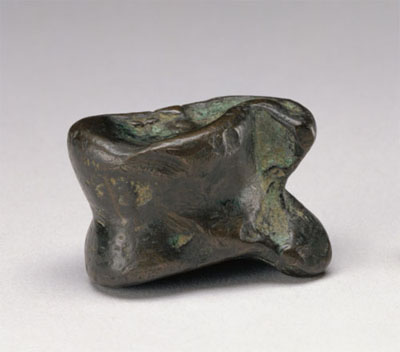
An ancient Greek astragalos or anklebone from the hind leg of a goat or sheep. While actual bones were often used for divination, this piece was cast in more durable bronze. Astragalos, 2nd–1st century B.C., Greek. Bronze, 3/4 x 1 3/4 x 3/4 in. The J. Paul Getty Museum, 81.AC.5. Gift of Arthur Silver
Inside this religious manuscript, the Sortes Sanctorum (“holy lots”) are instructions for answering your burning questions about the future. Five of us decided to give it a try.
- What Is Divination?
- How Divination Works
- Who We Are + What We Asked
- How Did Fasting Go?
- Pre-Ceremony
- The Ceremony
- Would We Recommend Medieval Divination?
What Is Divination?
Divination is a process used to gain insight into future events. In the ancient world, methods of divination ranged from interpreting the spots on the livers of animals to casting “lots” (dice usually made of animal bones) to reading the flight patterns of birds—a technique known as augury.
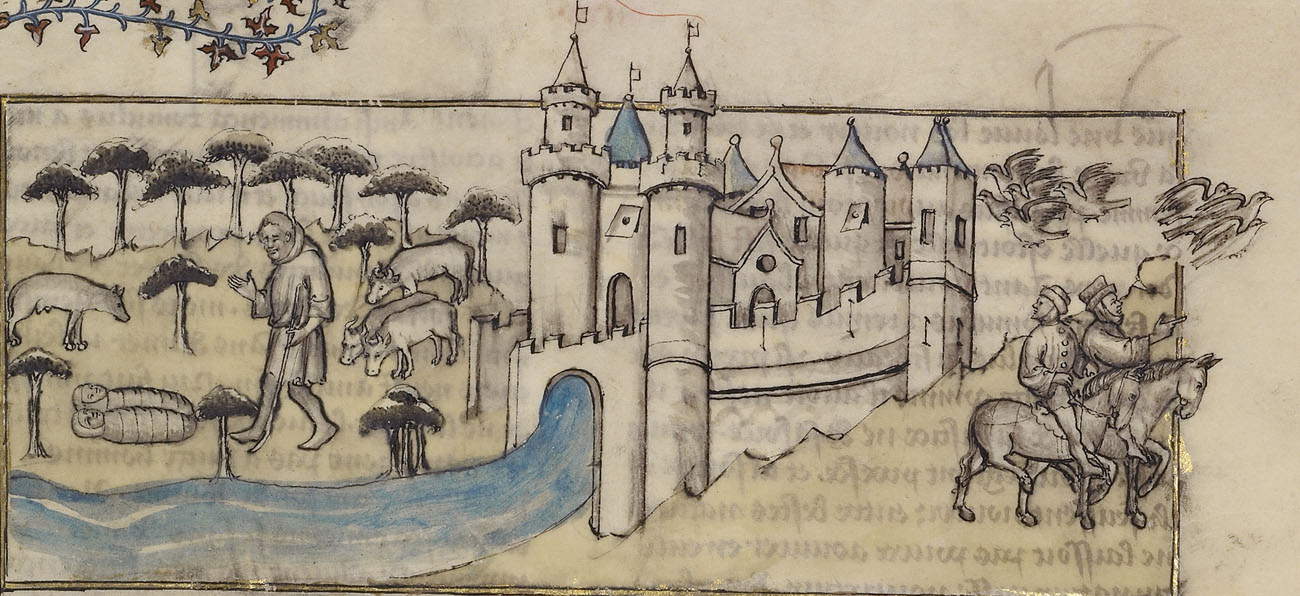
A medieval interpretation of ancient augury shows Romulus and Remus using the flight of certain types of birds to determine where to found the city of Rome. Romulus and Remus (detail), about 1390–1400, First Master of the Bible historiale of Jean de Berry. Tempera colors, gold leaf, and ink on parchment; leaf: 15 1/16 x 11 9/16 in. The J. Paul Getty Museum, Ms. Ludwig XIII 3 (83.MP.146), leaf 4. Digital image courtesy of the Getty’s Open Content Program
By the twelfth and thirteenth centuries, classical Greek and Arabic texts on divination had been translated into Latin. This new knowledge of magic quickly spread throughout France, Italy, Germany, and England.
Medieval universities were major sites for the production and study of magical texts. Because divination often relied on the position of stars, the subject was considered part of astronomy, one of the seven liberal arts that also included grammar, rhetoric, dialectic, arithmetic, music, and geometry.
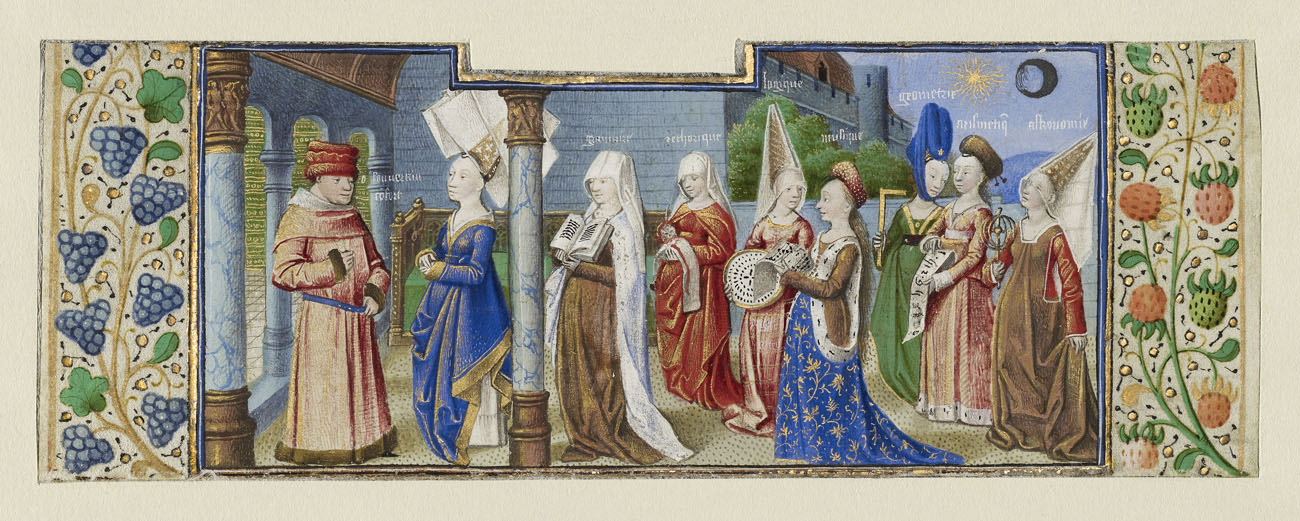
Boethius (far left) speaks with Philosophy, who introduces him to personifications of the seven liberal arts taught in medieval universities. From left to right: Grammar, Rhetoric, Logic, Music, Geometry, Arithmetic, and Astronomy. A sun and moon hang above Astronomy, who holds a simplified celestial globe in her hands. Philosophy Presenting the Seven Liberal Arts to Boethius (detail), about 1460–70, Coëtivy Master (Henri de Vulcop?). Tempera colors, gold leaf, and gold paint on parchment; leaf: 2 3/8 x 6 11/16 in. The J. Paul Getty Museum, Ms. 42, leaf 2v, 91.MS.11.2.verso. Digital Image courtesy of the Getty’s Open Content Program
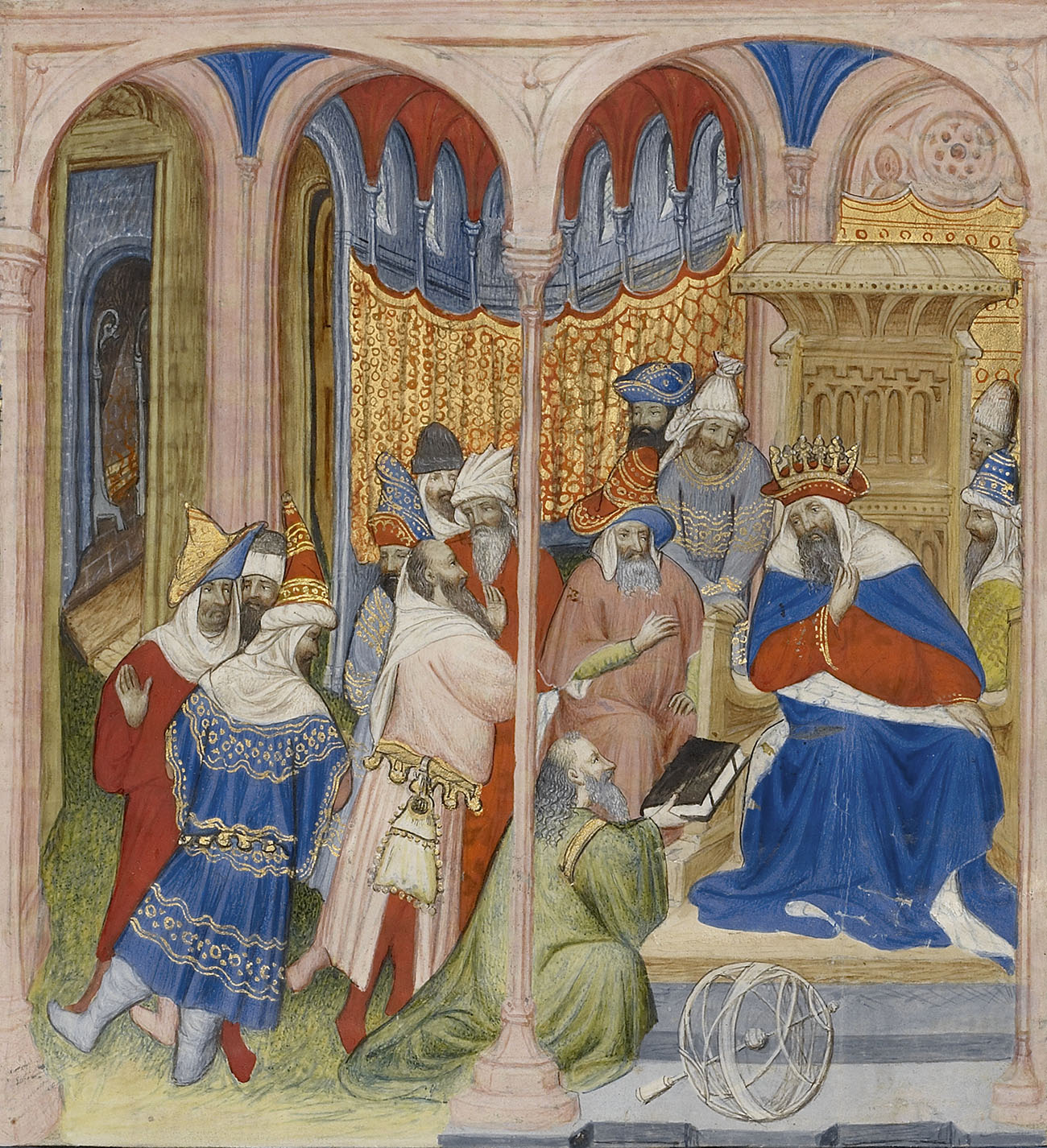
The philosopher Alchandreus offers his text to a king; the armillary sphere at his feet suggests the astrological nature of his work. Alchandreus Presents His Work to a King (detail), about 1405, Virgil Master. Tempera colors, gold paint, gold leaf, and ink on parchment; leaf: 15 3/8 x 12 in. The J. Paul Getty Museum, Los Angeles, Ms. 72, fol. 2, 2003.25.2. Digital image courtesy of the Getty’s Open Content Program
The divinatory text we’re consulting, the Sortes Sanctorum, has been updated from its classical ancestors by calling upon Christian saints to give readers insight into the future. It comes from the Getty Museum manuscript known as Ms. Ludwig XII 5, a book containing a collection of texts on topics that range from science to history to philosophy.
Although this version called upon saints rather than the stars, divination occupied an uncomfortable position within medieval Christianity because it threatened the authority of the Church. Yet the use of a book to determine the future has its Christian origins in Saint Augustine, who was converted after he opened a nearby Bible and read the first passage that he saw.
How It Works
Divination instructions in medieval manuscripts can be very lengthy, sometimes requiring as many as nine masses to be said before any foretelling can occur. For the sake of time, and because this manuscript now exists within a museum rather than a consecrated space where mass can be performed, we’ve simplified the process just a bit (but preserved the full rules for good measure).
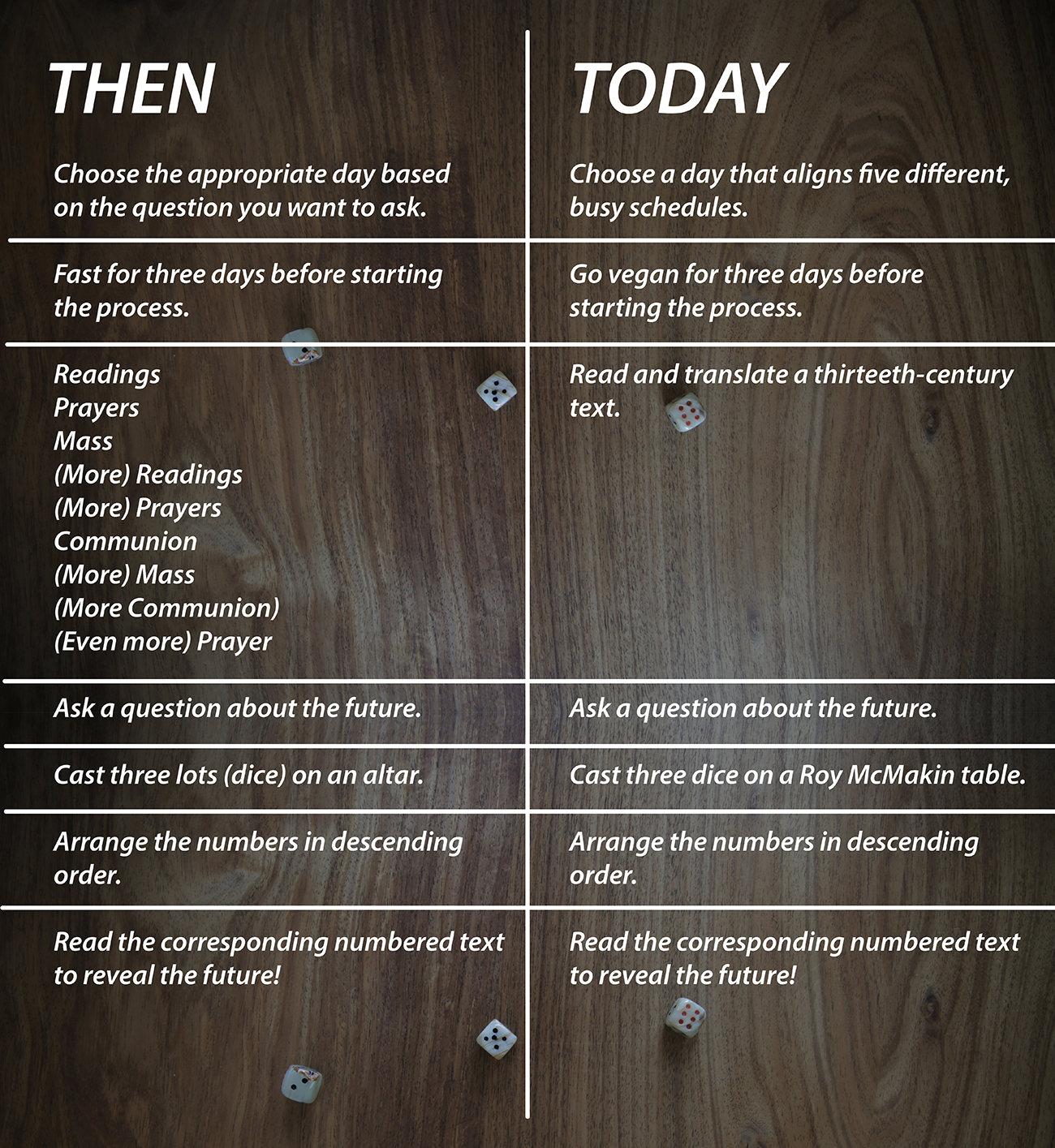
The Divination Rules. (Mobile users, see image full size here.)
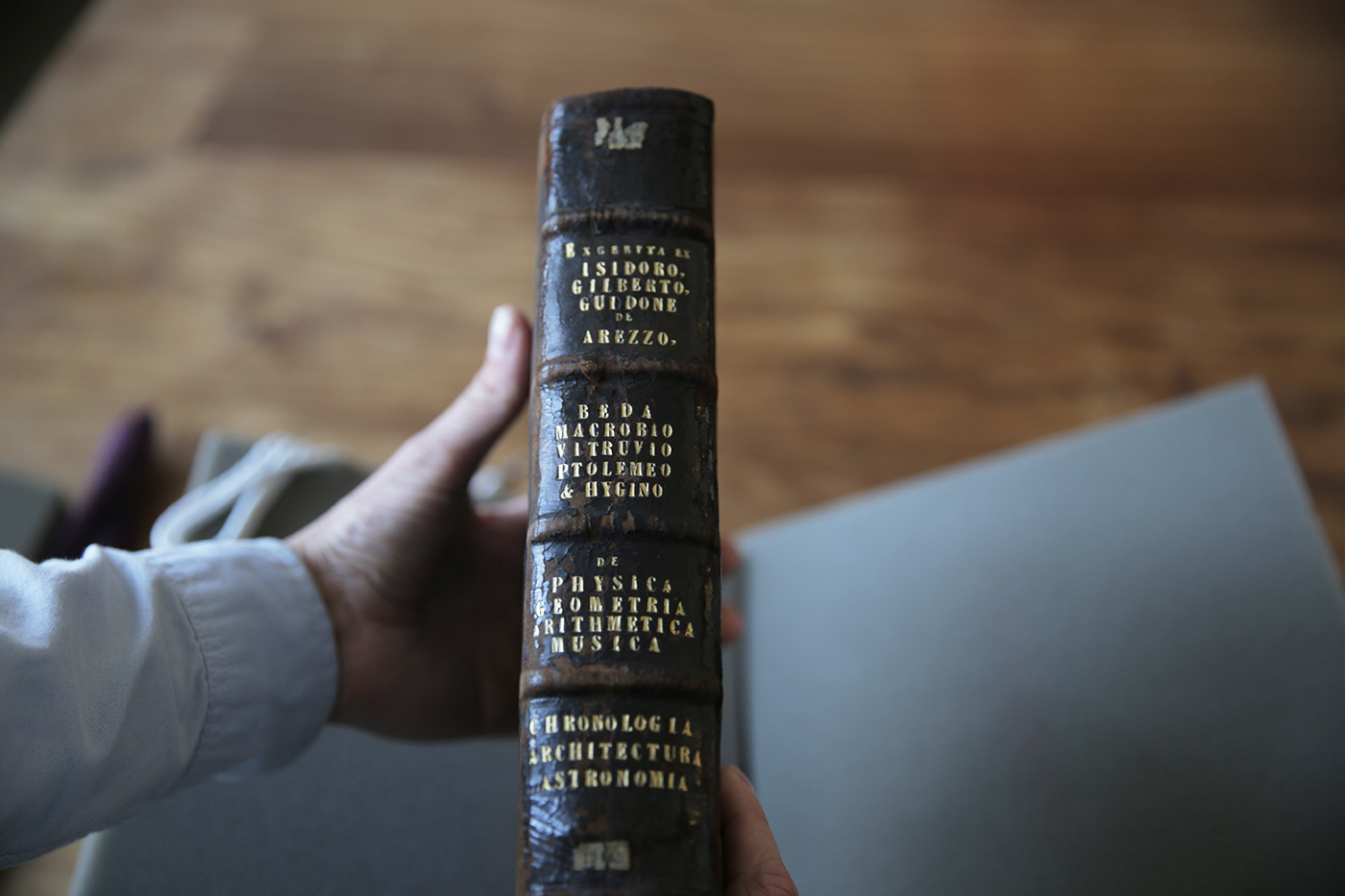
The spine of the book
Who We Are + What We Asked
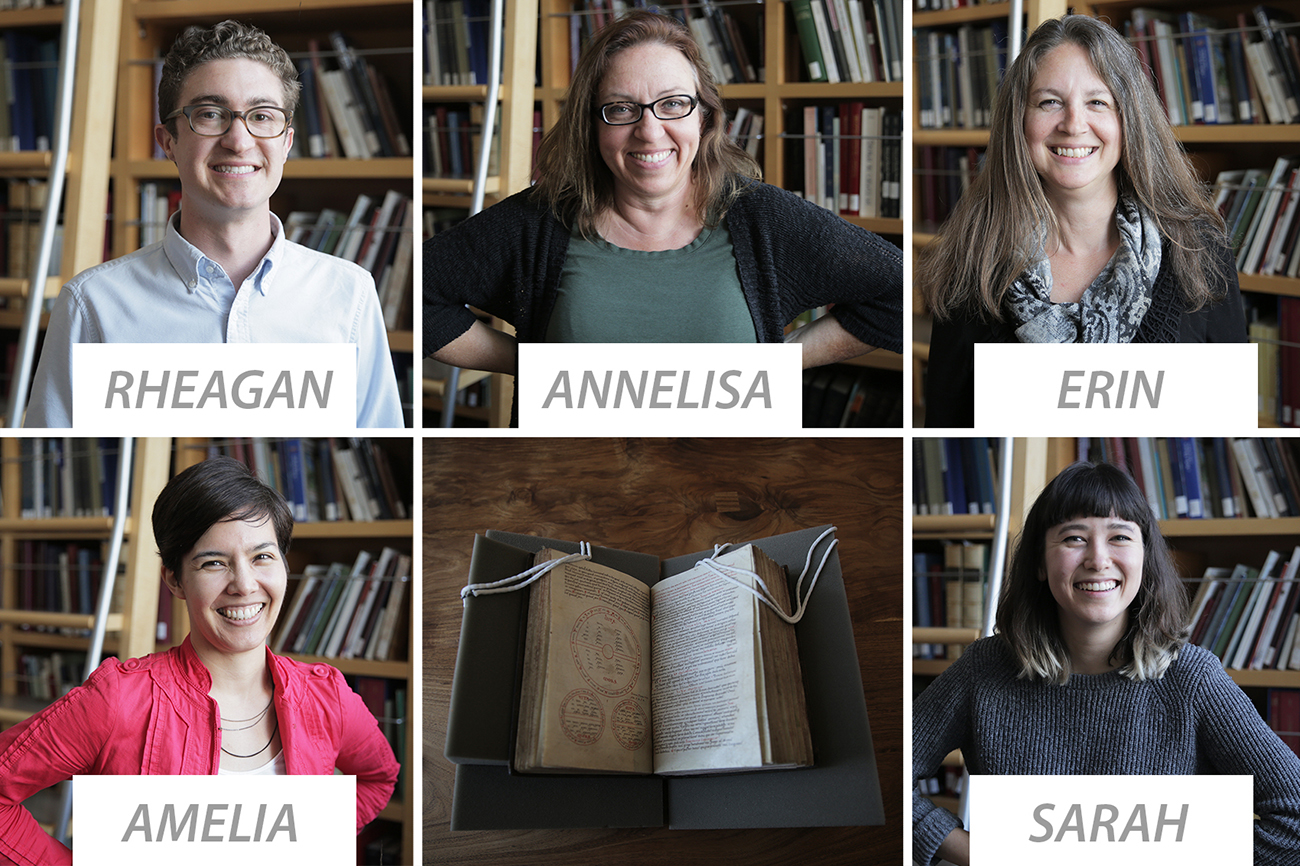
Rheagan Martin
Curatorial assistant, Department of Manuscripts, Getty Museum
I became interested in historical magical practices as part of my research on the influence of the classical world during the Middle Ages. I’m also fascinated by the perceived magical properties of gems during the middle ages and Renaissance, so magical texts add an exciting dimension to this research.
My question: Now that I’m preparing to leave Los Angeles for graduate school, will I return to the City of Angels anytime soon?
Annelisa Stephan
Manager for digital engagement, Getty Trust
I definitely believe in magic—things we can’t explain, see, or understand—and in the sacredness of all natural things. Fortune-telling, though? Meh. To me, dice and crystal balls seem to diminish the wonder of the world, not increase it. I’m an extremely literal person—I’m an editor by trade, for heaven’s sake!—but also drawn to shamanism and indigenous worldviews. I figured the book wouldn’t really get me, but who knows? Maybe it would finally explain everything.
My question: Are people truly good at heart?
Erin Branham
Manager of school and teacher programs, Getty Museum
I’ve long had an interest in systems of divination around the world, stemming from encountering a deck of Tarot cards when I was nine. Through the years, often in conjunction with exhibitions I’ve worked on at the Getty, I’ve had the opportunity to study the I Ching, the Yoruba system of Ifa divination, and ancient Chinese oracle bones. Working with the Getty Villa’s collection, I encountered ancient Roman augury (divination by studying the flight of birds) and the ancient Greek oracles. It was fascinating to learn that medieval manuscripts also held divination systems, so I jumped at the chance to take part in this project. Especially fascinating was learning about the required fasting and reading the fortunes contained in the manuscript.
My question: Will people in L.A. adopt more eco-friendly transportation over driving their own cars in the near future?
Amelia Wong
Web content strategist, Getty Trust
I don’t believe in fate or fortune-telling, but I think there is a lot of magic in the world—there’s so much we can’t explain. (And I choose to believe the Loch Ness monster is real, because how awesome would that be?) My prediction for how this is going to go: I’m afraid eating vegan for three days is going to give me a terrible headache—I tend to need a lot of protein. Regarding the divination, I expect there might be a lot of nervous laughter.
My question: Will I ever sail around the world on a sailboat?
Sarah Waldorf
Media producer, Getty Trust
I’ll admit that I knock on wood—it seems like the safe way to go when you’ve accidentally potentially disturbed fate and the universe. I don’t seek out fortune-telling or fate-testing opportunities, and messing with what we don’t understand does scare me a bit. But I do want to go through life open-minded, hearing out both the explicit and subtle signals from the living and the beyond.
My question: Will my allergies subside within the next year? (I’ve been in a battle this past year.)
How Did Fasting Go?
The strictest definition of fasting implies refusing all nutrients; however, art historian and food scholar Christina Normore has argued that medieval fasting simply omitted animal products. Considering that about half of the days on the medieval calendar were “fast” days, it’s very likely that medieval Christians relied on a plant-based diet on these days, while animal products were reserved for feast days. With this in mind, our fast consisted of a vegan diet for the three days leading up to our divination.
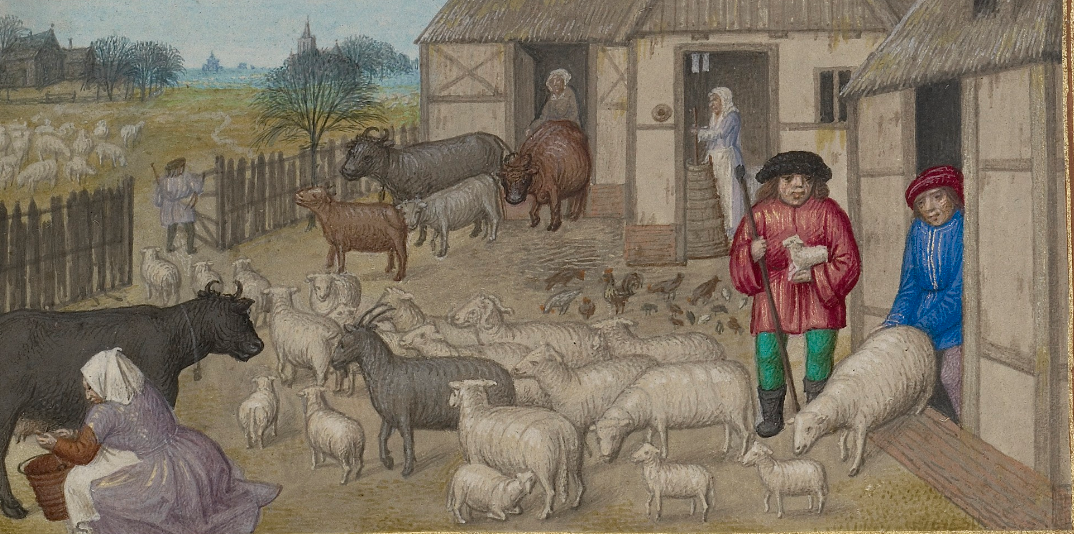
Farm Animals, Milking, and Buttermaking; Zodiacal Sign of Taurus, about 1510–20, Workshop of the Master of James IV of Scotland. Tempera colors, gold, and ink on parchment, 9 1/8 x 6 9/16 in. The J. Paul Getty Museum, 83.ML.114.3. Digital image courtesy of the Getty’s Open Content Program
Rheagan Martin
Creating vegan dishes was a fun challenge that encouraged me to approach grocery shopping and ingredients in new ways. One of my most successful vegan dishes was a plate of nachos with spicy pickled veggies.
Erin Branham
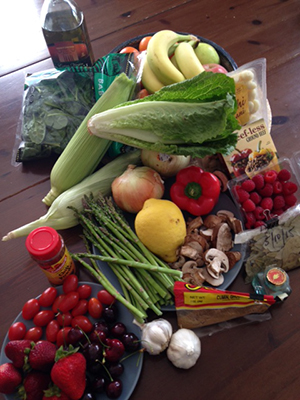
Veggie haul
Being majorly in love with cheese, I’d probably never be vegan forever, but I’ll try anything once! I grew up in the Southeast, where my mom had a vegetable patch in the backyard and most dinners included at least three veggies, so a plant-based diet just reminded me of summers back home. A little internet research turned up a recipe for paella primavera that was so good I’ll definitely be making it again and again.
Annelisa Stephan
I’ve been vegetarian since I was 11, but going vegan put me in a mild panic: I realized that my entire meager cooking repertoire consists of putting large quantities of butter on various forms of wheat. Luckily, my partner cooks, so I was able to enjoy treats such as vegan banana bread and artisanal almond butter from Gjusta. Unfortunately I also started fasting one day late by mistake, which meant that I “accidentally” ate a substantial portion of a banana cream pie. I am a terrible person.
Amelia Wong
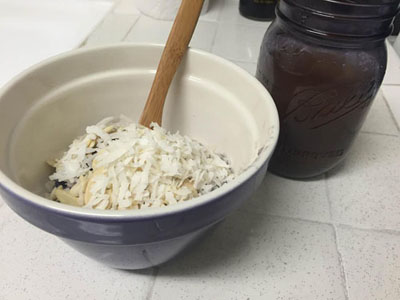
Almond milk oatmeal
The most difficult thing about fasting was remembering what not to eat out of habit. Also, reading ingredients to hunt out things like dairy derivatives. So, there was a lot of sudden disappointment: “Oh, I can eat this! Oh, no. Shoot.” I did discover as long as I ate enough fat (I ♡ avocados) in my meals that I could satisfy my hunger, even though I wasn’t eating as much protein as a I normally do. Turns out I am not a fan of alternative milks in coffee or tea, but almond milk worked well in my oatmeal.
Sarah Waldorf
Despite a spam-and-eggs-related misstep (and a few accidental dairy coffee creamers), the three days of fasting went great! I’ve been consciously trying meat-free recipes during the week, in part to reduce my carbon footprint, so this was a fun way to recipe test. I also realized I use cheese as my crutch for when a dish needs flavor. I had to get more creative.
Pre-Ceremony
Rheagan Martin
I was hoping for some positive outcomes, but reading through the list of possibilities it was a little frightening.
Erin Branham
I was just fascinated to learn how it worked. The many ways humans have tried to know the future is endless!
Annelisa Stephan
I was expecting something kinda Name of the Rose-like, for some reason? The book was smaller than I expected, and looked friendly, so that was a good sign.
Amelia Wong
I had basically no expectations, though, in the back of my mind, I thought candles might be involved since I relate fortune-telling with darkness (blame too many Ouija board experiments at sleepovers). I should have realized they wouldn’t be because we were going to be consulting a medieval manuscript in the Getty Museum’s Manuscripts Study Room. But, I like candles.
Sarah Waldorf
I was more preoccupied with the fear of accidentally throwing the dice on the book than I was with my own outcome.
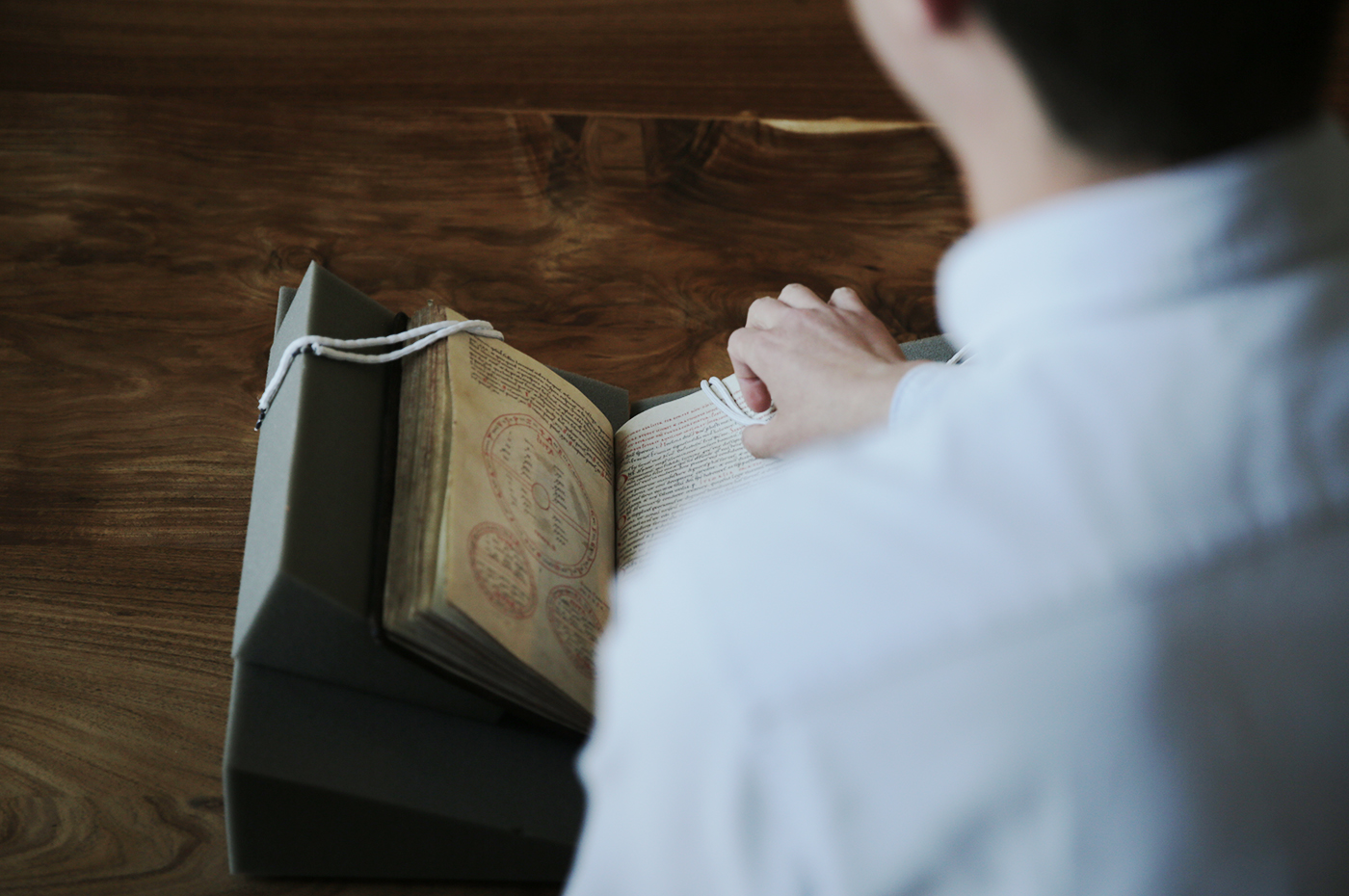
The Ceremony
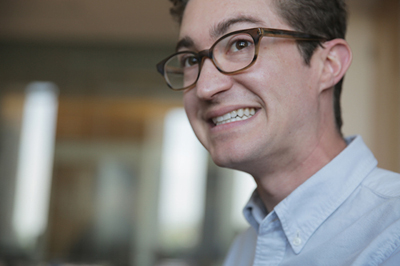 We all gathered in the manuscripts study room, a beautiful, naturally lit space with ample dice-rolling room. The book awaited our arrival, propped gently on foam. Each of us took a turn, first stating our question aloud, and then rolling the three dice. The dice were arranged in descending order. Then our fortunes were read aloud from a translation by Dr. Faith Wallis. The book was touched only by Rheagan, who is trained in safe handling of parchment.
We all gathered in the manuscripts study room, a beautiful, naturally lit space with ample dice-rolling room. The book awaited our arrival, propped gently on foam. Each of us took a turn, first stating our question aloud, and then rolling the three dice. The dice were arranged in descending order. Then our fortunes were read aloud from a translation by Dr. Faith Wallis. The book was touched only by Rheagan, who is trained in safe handling of parchment.
Rheagan Martin
Dice rolled: 5, 5, 2
Question: Now that I’m preparing to leave Los Angeles for graduate school, will I return to the City of Angels anytime soon?
Book’s Answer: You seek to be put in a forest where you will find no path, and many powerful serpents hide there to harm you. Therefore, give up this plan—just when you think you go safely, you will be deceived by your faults.
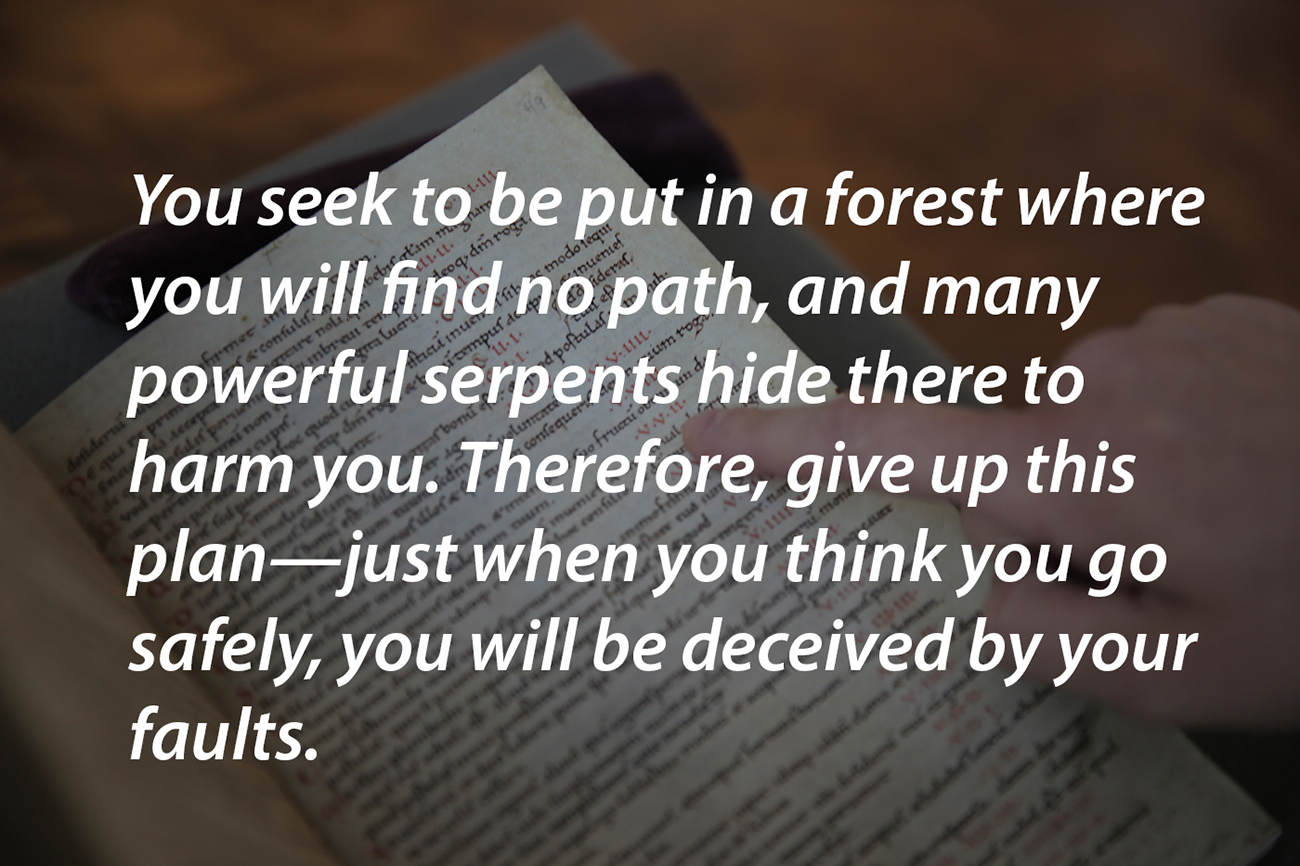
Book’s answer for Rheagan
Erin Branham
Dice rolled: 6, 5, 2
Question: Will people in L.A. adopt more eco-friendly transportation over driving their own cars in the near future?
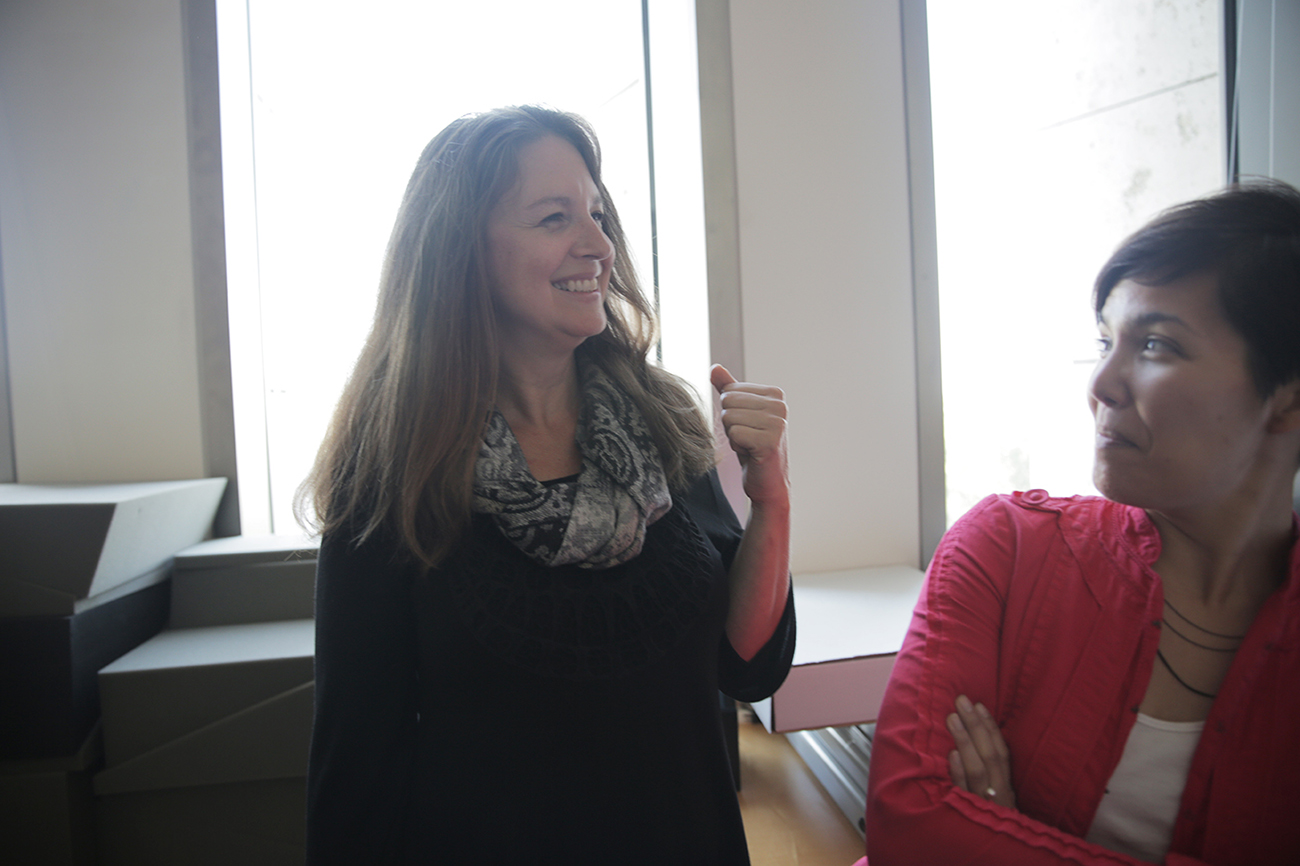
Book’s Answer: You want to seize the horns of a running stag while it is lingering in the woods; as soon as it returns to its lair you will be able to catch it, and what you are doubtful of will come into your hands.
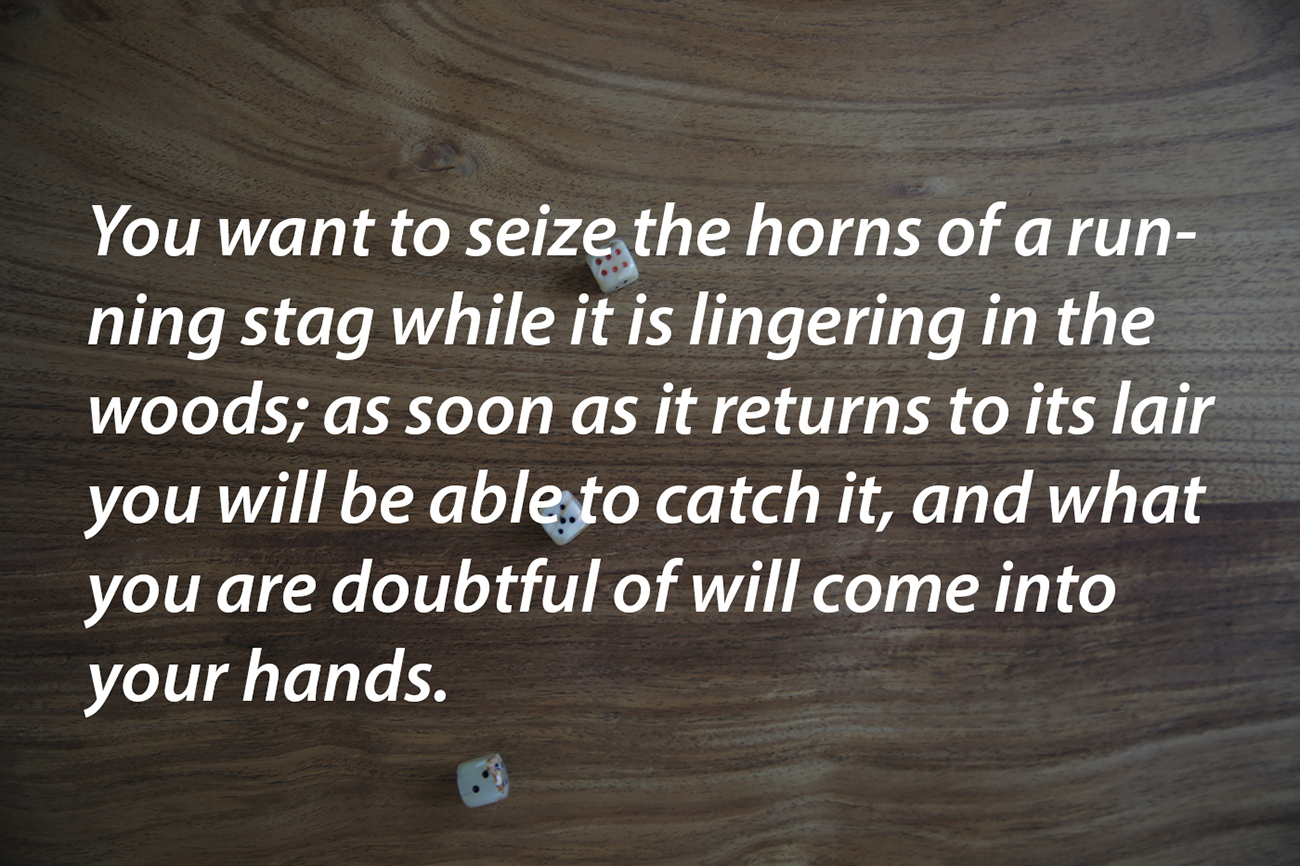
Book’s answer for Erin
Annelisa Stephan
Dice rolled: 6, 2, 2
Question: Are people truly good at heart?
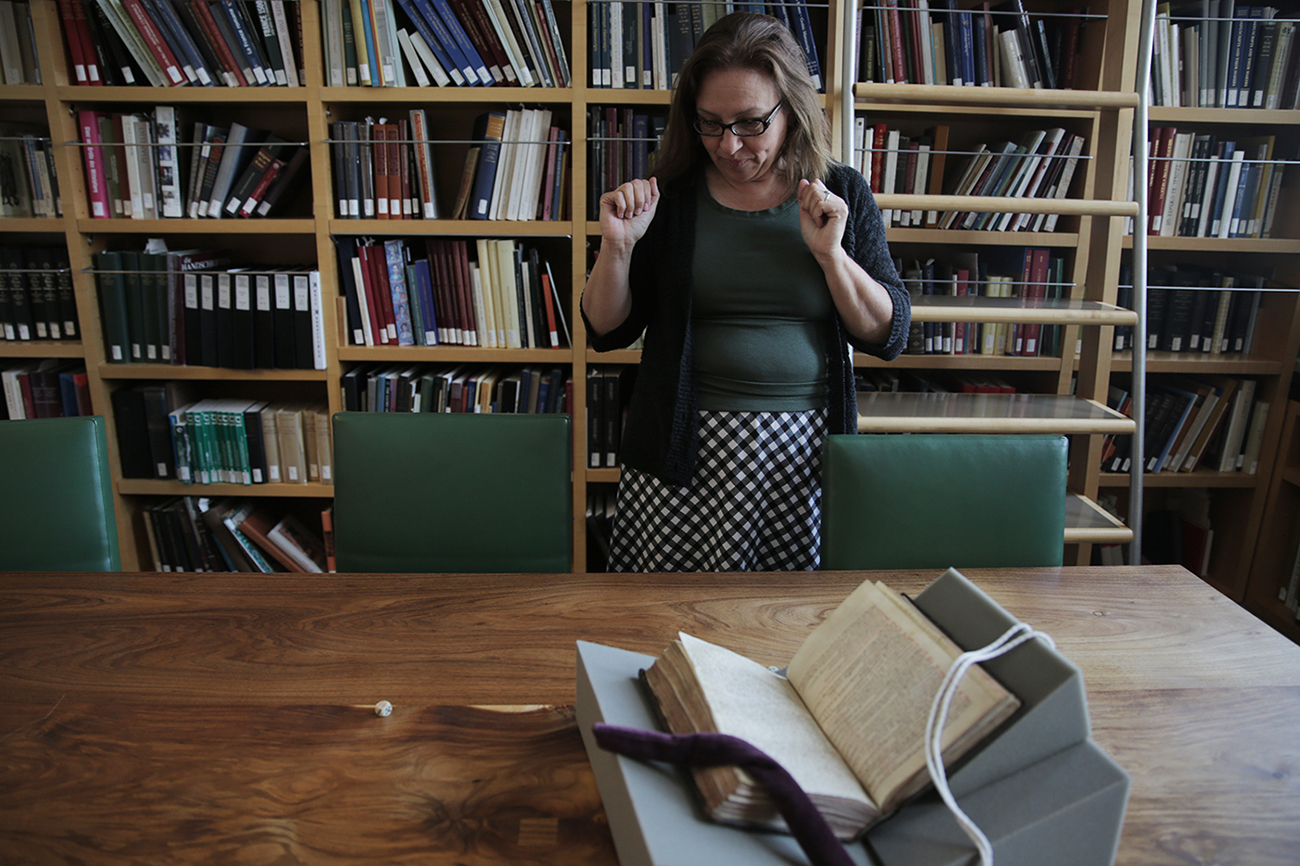
Book’s Answer: The way to what you desire is prepared, and you will find sorrow if you wish to follow this now. But be patient, and ask God, and you will receive a good time and find what you desire.
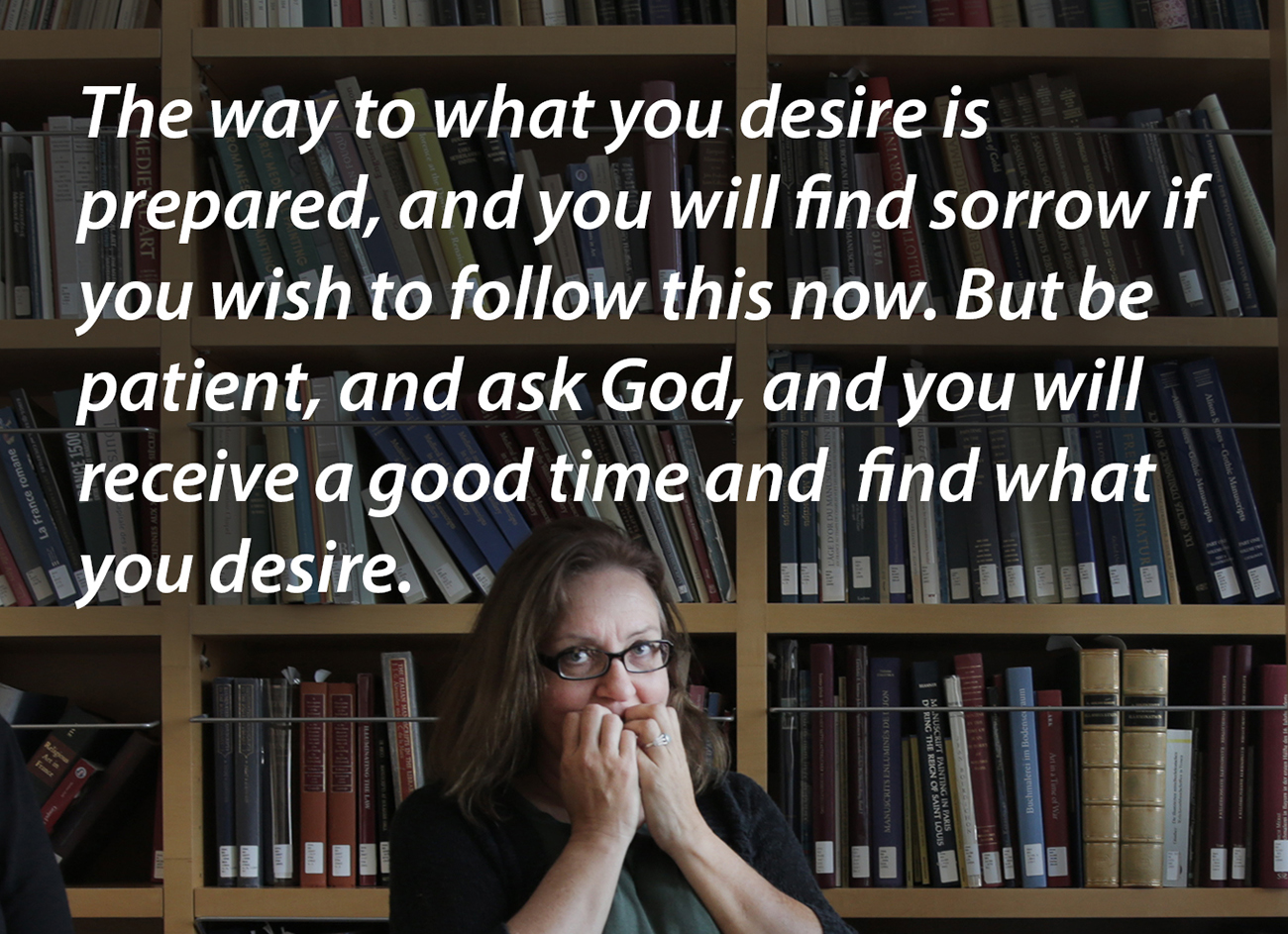
Book’s answer for Annelisa
Amelia Wong
Dice rolled: 3, 1, 1
Question: Will I ever sail around the world on a sailboat?
Book’s Answer: Now the entrance to what you desire lies open to you. Do not doubt, but ask God, and he will help you, and you will swiftly obtain what you want.
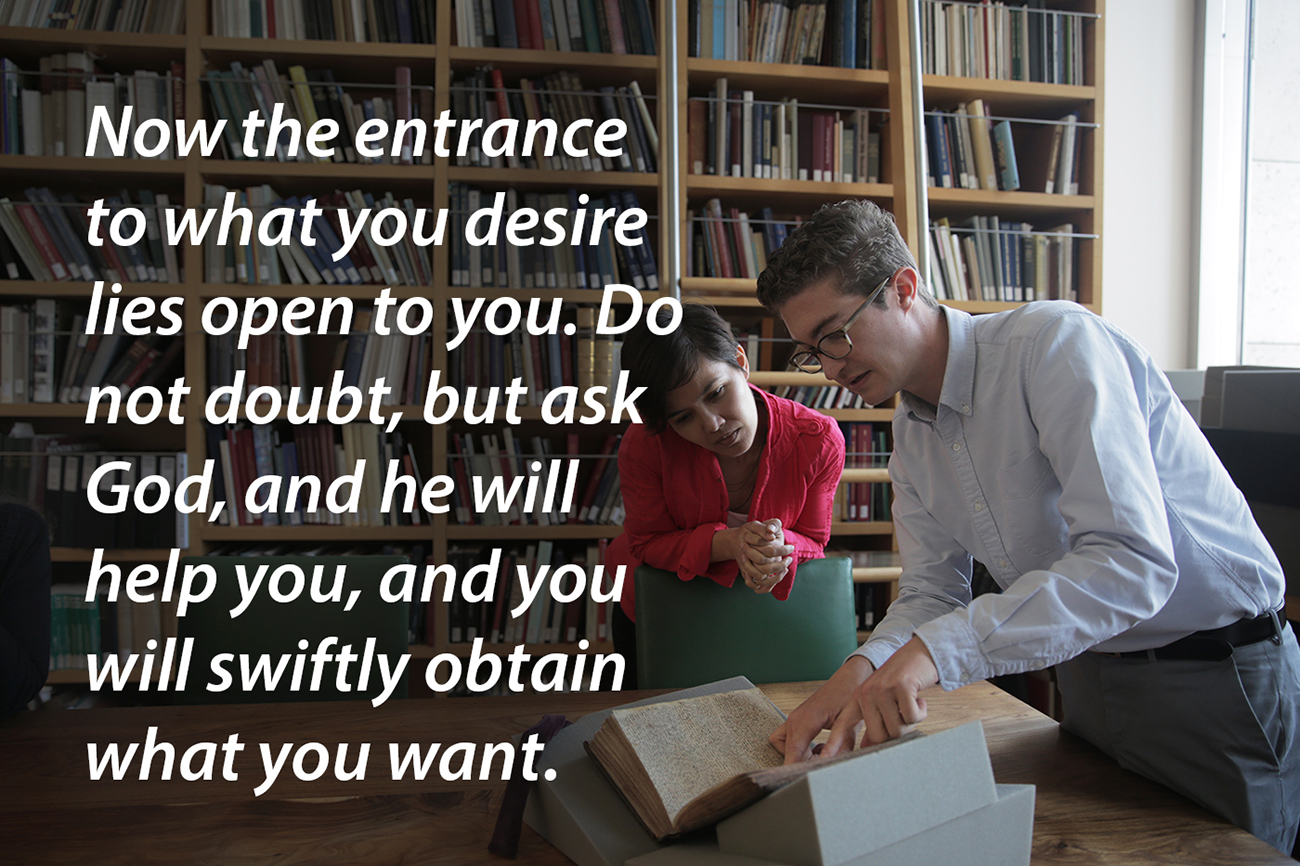
Book’s answer for Amelia
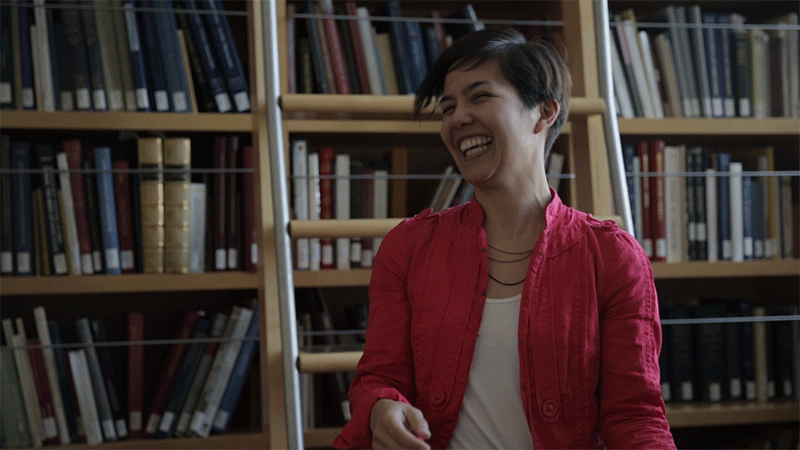
Not bad.
Sarah Waldorf
Dice rolled: 5, 4, 3
Question: Will my allergies subside within the next year?
Book’s Answer: You say you have an opponent; place your hope in God that he might help you. I warn you, do not think of failing to take action.
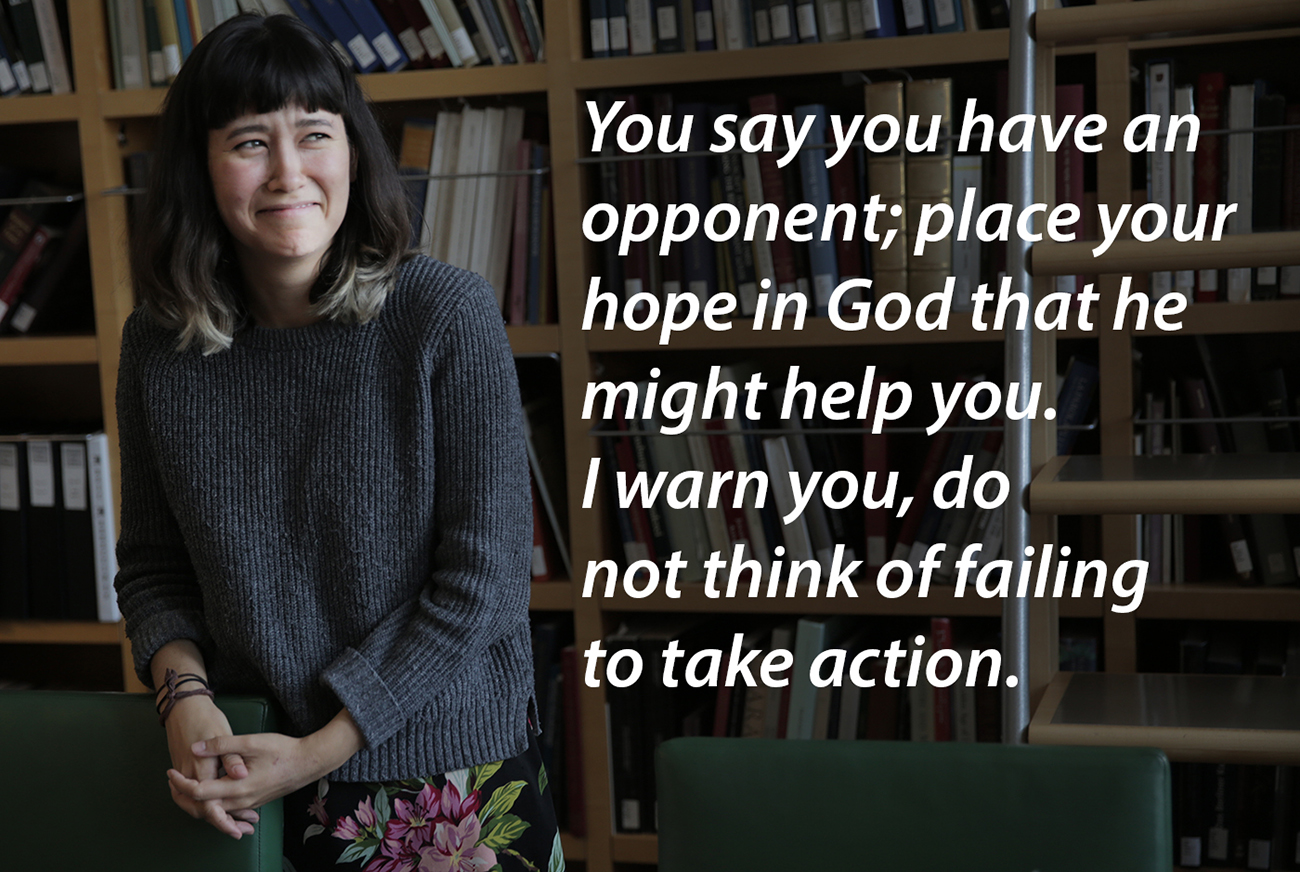
Book’s answer for Sarah
Would We Recommend Medieval Divination?
Rheagan Martin
I discovered that the answers were more difficult to apply than we originally thought. Metaphorical imagery of dark forests and serpents were hard to relate to the twenty-first-century questions we asked. After some discussion we seemed to come up with our own interpretations and ideas—maybe that was part of the medieval process as well!
I was quite surprised by the ominous response to my question about returning to Los Angeles: “You seek to be put in a forest where you will find no path, and many powerful serpents hide there to harm you. Therefore give up this plan—just when you think you go safely, you will be deceived by your faults.” I’m hoping that my accidental non-vegan slip-up (a morning cappuccino) may have skewed the results.
I would definitely recommend engaging with illuminated manuscripts in the way they were intended, but be prepared!
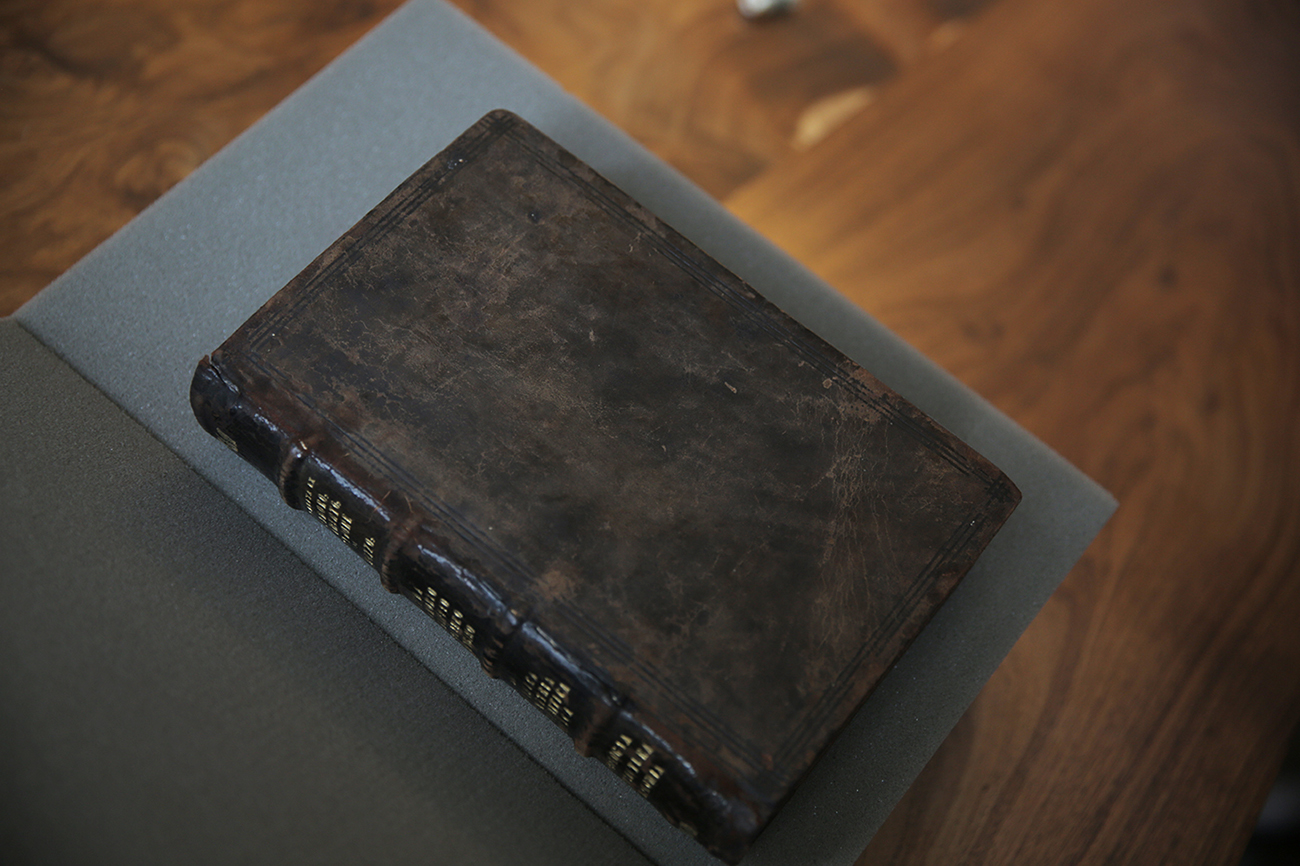
Erin Branham
Not to get too New Agey, but I think there’s a little something to divination, rolling off of the ideas of synchronicity and probability. At the very least, I find it a fertile way to engage in self-reflection.
What was absolutely great about this ceremony was the metaphorical nature of the fortunes—very mysterious and ponderable, which is how it is in most of the divination systems I’ve ever learned about. People sometimes approach divination as if it is giving you information set in stone (if they believe in it) , or as if it is nonsense gobbledygook (if they don’t), but I see it as a way of creatively contemplating reality which is, to steal some excellent words from David Brooks, is “paradoxical, complementary, and unfolding.”
Divination can let you look at possible outcomes, possible meanings, and possible paths so that you can go deep into what you are bringing to a situation and decide if you want to continue on a course, or try something different. I’d certainly recommend medieval divination. I really liked the challenge of fasting beforehand. And I was very encouraged by the answer—trying “to seize a running stag while it is lingering in the woods” seemed to refer to the cars Angelenos so love and are not quite ready to give up. But “the stag returns to its lair in time” is a restful image, and “what you are doubtful of will come into your hands” implies that, with a little time, even Los Angeles can become a mass-transit city.
Annelisa Stephan
I loved my answer! Yes, it was slightly ominous—“you will find sorrow if you wish to follow this now” was not exactly…motivational? But sometimes you need a stern lecture. Since I was a girl I’ve been fascinated by the question of whether people are really “good.” I want to believe! But as I interpret it, the manuscript was telling me to stop thinking dichotomously. The pursuit of impossible certainties, it was saying, would drown anyone in sorrow. So stop.
Not long after the divination, I was able to take action on a long-festering problem in my life, and to think of the people involved not as good or bad, but just as how they are. I guess the book made me a Buddhist? Anyway, I would recommend tough love from a medieval manuscript to anyone. Five stars.
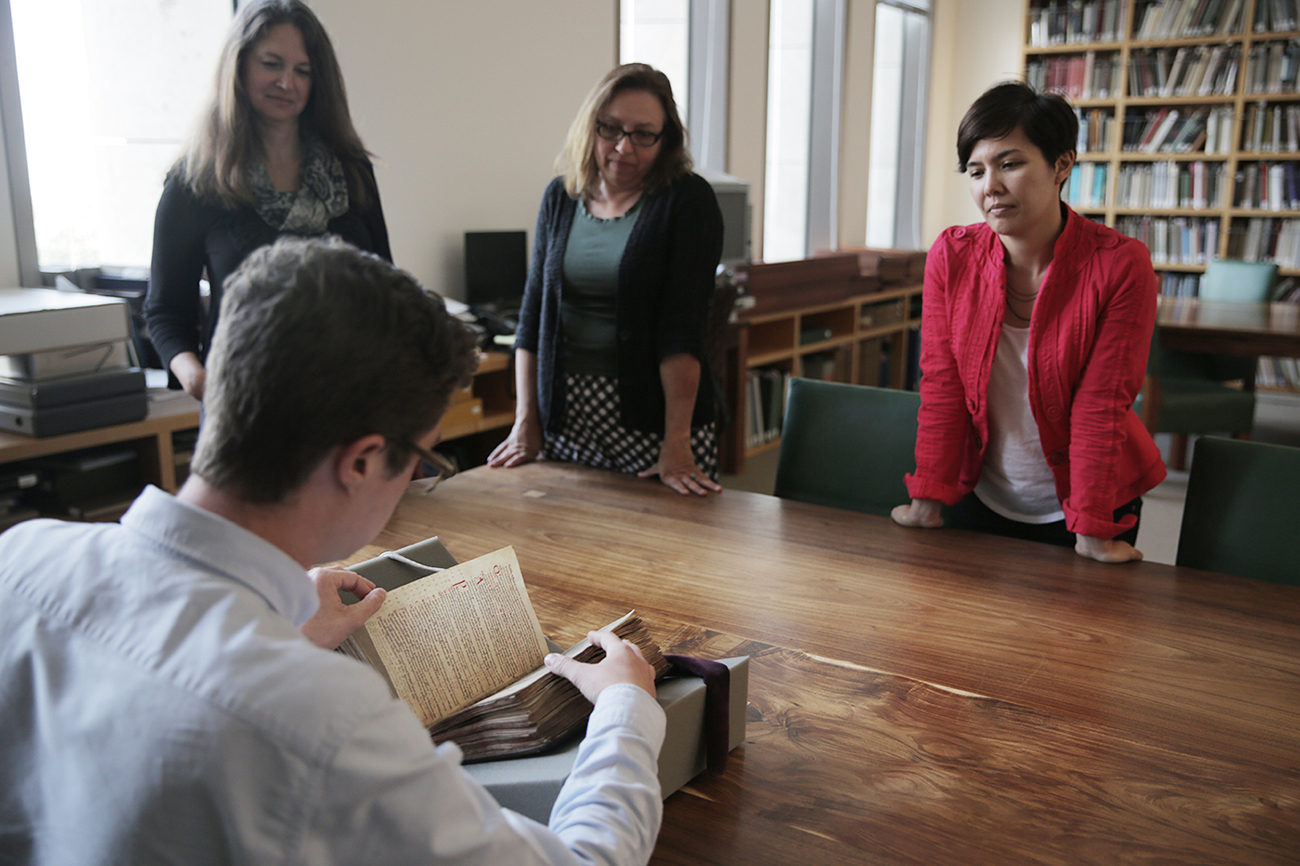
Front left: Rheagan. Rear, left to right: Erin, Annelisa, Amelia
Amelia Wong
I realize it’s very different to do a modern version of a medieval practice, but I found it was really intriguing to participate in a ritual people would have centuries ago. While it was entertaining and educational for us, I wondered how people in the thirteenth century would have approached it.
Did they believe the pronouncements of the book? Or would they also mull them over with friends afterwards, wondering what they meant and laughing off dire-sounding predictions? Or perhaps they would laugh them off and then secretly fret about them and lay plans to do yet another reading? I felt a lot of sympathy for how people—then and now—would like answers to questions and what lengths we will go to get them.
It also came to mind how superstitious I can be, even though I am not religious and don’t believe in fate. I didn’t want to ask the book a question about which I would care too much about the answer (nor, full disclosure, have something I really cared about published on the Getty’s blog). I felt an unexpected degree of glee when I got such a positive answer to my question, since I really would like to sail around the world on a sailboat. I know I would have been a little disappointed if the divination had said, “No chance.” (But, I am also sure I would have had impolite thoughts about the wisdom of the book, something along the lines of, “Well, I’ll show you!”)
I would definitely recommend medieval divination to people, as long as they don’t put too much stock in the outcome. You be the boss of you.
Sarah Waldorf
This outcome struck me in two ways—one, that I’m often paralyzed by anxiety and fear, and two, that I can’t be my own opponent.
I’m both a conflict-avoider and people-pleaser, so the path I choose is often one of least resistance. The book warned me to “not even think of failing to take action,” and if that’s not an on-the-nose sign to stop letting decisions wash over me, I don’t know what is.
And, without going into too much gnarly detail, I’ve been working through some worsening skin allergies in the last few months. I’ve seen all kinds of doctors, Western and Eastern, in the hopes of winning against my allergies, my “opponent” as the book put it. But, not everything should be a battle, especially not with your own health and being. Changing my mindset has already shown health benefits.
Are you the type of person to overanalyze any potential sign from the universe? Do you hate making choices alone? Medieval divination may be for you.
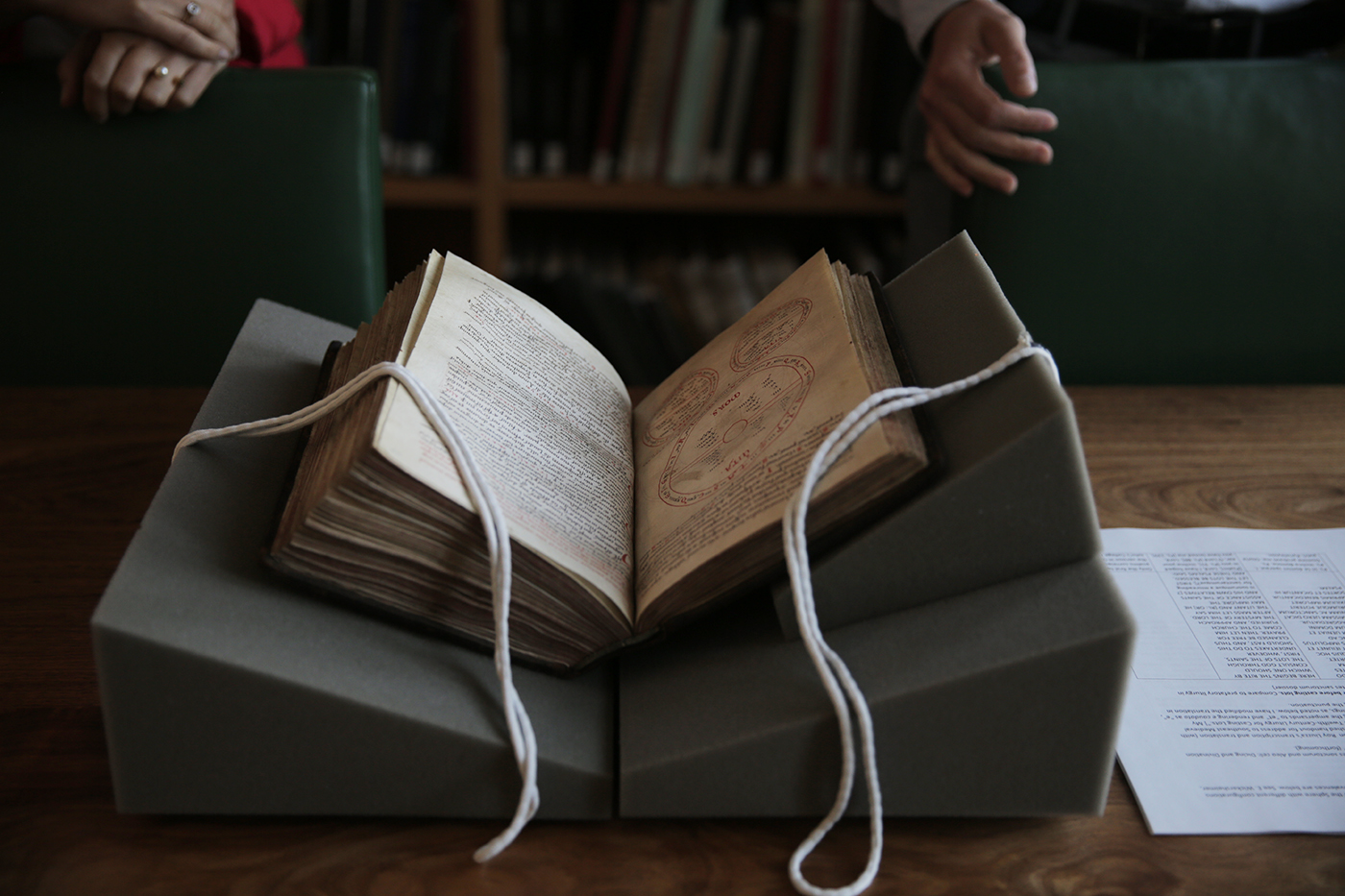
We would like to thank Dr. Faith Wallis for generously sharing her work on the Getty manuscript containing the divination text.


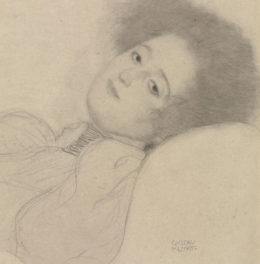


An interesting exercise; but how to ‘get into’ a Mediaeval world-view may be harder than the fasting- by far! AND you left out the scrupulous religious devotions, prayer and Mass! Oh well, better ‘fortune’ next time, maybe you need a volunteer to say Mass for you also- I’d be happy to oblige!
Thank you for reading and for being quick to volunteer for round two!
I cast the lots for Donald Trump and Hillary Clinton in the I Ching. Trump drew Hexagram 18, which ends with the subject tending to his private affairs. Clinton drew #27, which ends with the subject having a hard task and great responsibility. These comments are in the footnotes to the James Legge translation. We shall see if either applies!
I can absolutely guarantee that the people who used this book back in the Middle Ages probably did believe these pronouncements. The Middle Ages were a time when people were highly religious and their religion permeated though all aspects of their lives, which helps explain the numerous Masses and praying and other spiritual activities. Plus fasting was even more rigorous, they probably only ate a single meal for the day. And if done on a village level, the parish priest would have been involved as well. These folkish “magic” beliefs did seep into Christianity at the time, and while the Church hierarchy never officially sanctioned any of it and would often condemn to one level or another, it didn’t really stop a lot of people because it was seen as “white magic.” The “black magic,” necromancy, raising the dead, that kind of thing was always highly condemned and forbidden.
But this was an interesting read nonetheless.
Rheagan
I wrote my doctorate thesis on the effect of gemstones on human neurological functioning.
If you are interested, there is much to share.
Contact me if you like
Robert Frost
http://drrobertfrost.com
Where can we read Dr. Wallis’s translation?
Hello Jennifer!
Dr. Wallis hasn’t published the translation yet, but did write about the book! You can see her published works on her Academia.edu page: http://mcgill.academia.edu/FWallis
Hope this helps!
Sarah
In, Tarot readings it is usually suggested to not ask “yes” or “no” questions. You might get an answer that leads you to conclude yes/no/up/down/whatever, but the answer itself might be more relevant and prompt you to think in new ways regarding your questions.